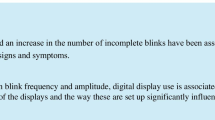Abstract
Blinking is essential in maintaining eye health. The lack of blinking may lead to dry eyes, which usually happens when reading paper books. The previous blink acceleration system prompted users to blink effectively, but mandatory blinking made users uncomfortable. If users stop using the blink acceleration system, the number of blinks will reduce. Therefore, we proposed a new blink acceleration system using classical conditioning to prompt to blink when reading paper books unconsciously. Specifically, the number of blinks would increase while reading paper books because of the association between page-turning action and blinking by using the system that assigns blinking to the page-turning action when reading e-books. As a result of our evaluation experiment, the number of blinks increased for some participants with our system. There is a possibility of increasing the number of blinks while reading paper books by periodically using the proposed blink acceleration system.
Access this chapter
Tax calculation will be finalised at checkout
Purchases are for personal use only
Similar content being viewed by others
References
Yamada, M., Mizuno, Y., Shigeyasu, C.: Impact of dry eye on work productivity. ClinicoEconom. Outcomes Res. 4(4), 307–312 (2012)
Ponder, E., Kennedy, W.P.: On the act of blinking. Q. J. Exp. Physiol. 18(2), 89–110 (1927)
Orchard, L.N., Stern, J.A.: Blinks as an index of cognitive activity during reading. Integr. Physiol. Behav. Sci. 26(2), 108–116 (1991). https://doi.org/10.1007/BF02691032
Bentivoglio, A.R., Bressman, S.B., Cassetta, E., Carretta, D., Tonali, P., Albanese, Dr.A.: Analysis of blink rate patterns in normal subjects. Off. J. Int. Parkinson Mov.Disord. Soc. 12(6), 1028–1034 (2004)
Miura, D.L., Hazarbassanov, R.M., Yamasato, C.K.N., Silva, F.B., Godinho, C.J., Gomes, J.P.: Effect of a light-emitting timer device on the blink rate of non-dry eye individuals and dry eye patients. British J. Ophthalmol. 97(8), 965–967 (2013)
Lois, N.O., John, A.S.: DualBlink: a wearable device to continuously detect, track, and actuate blinking for alleviating dry eyes and computer vision syndrome. In: Proceedings of the ACM on Interactive, Mobile, Wearable and Ubiquitous Technologies, IMWUT 2017, pp. 1–19 (2017)
Mauk, M.D., Steinmetz, J.E., Thompson, R.F.: Classical conditioning using stimulation of the inferior olive as the unconditioned stimulus. In: Proceedings of the National Academy of Sciences of the United States of America, pp. 5349–5353 (1986)
Sears, L.L., Finn, P.R., Steinmetz, J.E.: Abnormal classical eye-blink conditioning in autism. J. Autism Dev. Disord. 24, 737–751 (1994). https://doi.org/10.1007/BF02172283
Clark, L.E., Squire, L.R.: Human eyeblink classical conditioning: effects of manipulating awareness of the stimulus contingencies. Psychol. Sci. 10(1), 14–18 (1999). https://doi.org/10.1111/1467-9280.00099
Crnovrsanin, T., Wang, Y., Ma, K.L.: Stimulating a blink: reduction of eye fatigue with visual stimulus. Conf. Hum. Factors Comput. 31(3), 2055–2064 (2014)
Portello, J.K., Rosenfield, M., Chu, C.A.: Blink rate incomplete blinks and computer vision syndrome. Optomeetry Vision Sci. 90(5), 482–487 (2013)
Arcediano, F., Ortega, N., Matute, H.: A behavioral preparation for the study of human pavlovian conditioning. Q. J. Exp. Psychol. 49(3), 270–283 (1996)
Aizenberg, M., Geffen, M.N.: Bidirectional effects of aversive learning on perceptual acuity are mediated by the sensory cotex. Nat. Neurosci. 16(8), 994–996 (2013)
Neumann, D.L., Waters, A.M.: The use of an unpleasant sound as an unconditional stimulus in a human aversive pavlovian conditioning procedure. Biol. Psychol. 73(2), 175–185 (2006). https://doi.org/10.1016/j.biopsycho.2006.03.004
Watson, J.B., Rayner, R.: Conditioned emotional reactions. J. Exp. Psychol. 3(1), 1–14 (1920)
Futami, K., Terada, T., Tsukamoto, M.: Success imprinter: a method for controlling mental preparedness using psychological conditioned information. In: Proceedings of the 7th Augmented Human International Conference 2016, AH 2016, pp. 1–8 (2016)
George, W.O.III., Hagberg, K.W., Schindelar, M., Welch, D., Abelson, M. B.: The ocular protection index. J. Cornea External Disease 27(5), 509–513 (2008)
Acknowledgements
This work was supported by JST CREST Grant Number JPMJCR18A3, Japan.
Author information
Authors and Affiliations
Corresponding author
Editor information
Editors and Affiliations
Rights and permissions
Copyright information
© 2023 The Author(s), under exclusive license to Springer Nature Switzerland AG
About this paper
Cite this paper
Uchida, J., Terada, T., Tsukamoto, M. (2023). Does Use of Blink Interface Affect Number of Blinks When Reading Paper Books?. In: Delir Haghighi, P., Khalil, I., Kotsis, G., ER, N.A.S. (eds) Advances in Mobile Computing and Multimedia Intelligence. MoMM 2023. Lecture Notes in Computer Science, vol 14417. Springer, Cham. https://doi.org/10.1007/978-3-031-48348-6_6
Download citation
DOI: https://doi.org/10.1007/978-3-031-48348-6_6
Published:
Publisher Name: Springer, Cham
Print ISBN: 978-3-031-48347-9
Online ISBN: 978-3-031-48348-6
eBook Packages: Computer ScienceComputer Science (R0)




